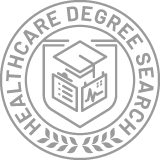District of Columbia Healthcare Colleges
In terms of yearly healthcare graduations, District of Columbia is ranked #42 in the country with 3,705 degrees handed out in 2021. The average in-state tuition for students attending college in District of Columbia is $32,299 a year, while the average out-of-state tuition is $32,922 a year.
An estimated 39% of college students in District of Columbia take out loans, with the average loan amount being $7,318 per year.
Featured schools near , edit
Most Popular Healthcare Schools in District of Columbia
Learn more about the most popular schools below:
There are 11,763 undergraduates at GWU, of which 10,141 are full-time, and there are 27,017 students altogether. The freshman retention rate at GWU is 90%, which is great when compared to the national average of 68%.
Roughly 38% of students at GWU take out loans to pay for college. The typical student loan amount is $10,893 a year.
Students who graduate from GWU with a bachelor’s degree make an average of $71,607 during the early years of their career after graduation.
Request Information
There are 7,357 undergraduates at Georgetown, of which 6,610 are full-time, and there are 19,371 students altogether. The average graduation time for an undergraduate student at Georgetown is 4.1 years.
Approximately 22% of the students who attend this school take out loans. The typical student loan amount is $8,982 a year.
The early-career average earnings of bachelor’s-degree holders from Georgetown is $83,222.
Request Information
The total student population at Howard University is 10,859, of which 7,857 students are undergraduates and of those, 7,497 are full-time. It takes the average Howard undergraduate about 4.2 years to complete their degree.
60% of Howard students take out loans to afford college costs. The typical student loan amount is $7,415 a year.
A typical bachelor’s-degree holder from this school earns an average of $47,379 during the early-career years.
Request Information
There are 1,846 students at Trinity College in total, 1,444 of which are undergraduates, and of those, 1,030 are full-time. For undergraduates at Trinity College, the average graduation time is 4.8 years.
Approximately 41% of the students who attend this school take out loans. The typical student loan amount is $4,857 a year.
Students who graduate from Trinity College with a bachelor’s degree make an average of $38,533 during the early years of their career after graduation.
Request Information
There are 14,001 students at The American University in total, 7,953 of which are undergraduates, and of those, 7,453 are full-time. It takes the average The American University undergraduate about 4.1 years to complete their degree.
45% of The American University students take out loans to afford college costs. The average amount of student loans is $9,129 a year.
The early-career average earnings of bachelor’s-degree holders from The American University is $61,328.
Request Information
There are 5,366 students at CUA in total, 3,055 of which are undergraduates, and of those, 2,934 are full-time. The average graduation time for an undergraduate student at CUA is 4.1 years.
54% of CUA students take out loans to afford college costs. The typical student loan amount is $10,152 a year.
A typical bachelor’s-degree holder from this school earns an average of $63,217 during the early-career years.
Request Information
The total student population at University of the District of Columbia is 3,725, of which 3,385 students are undergraduates and of those, 1,614 are full-time. It takes the average University of the District of Columbia undergraduate about 5.0 years to complete their degree.
Roughly 19% of students at University of the District of Columbia take out loans to pay for college. The typical student loan amount is $5,462 a year.
A typical bachelor’s-degree holder from this school earns an average of $36,358 during the early-career years.
Request Information
There are 1,019 undergraduates at Gallaudet, of which 905 are full-time, and there are 1,451 students altogether. The school has a student-to-faculty ratio of 6 to 1.
Roughly 27% of students at Gallaudet take out loans to pay for college. The typical student loan amount is $6,225 a year. The school reports a student loan default rate of 0.3% which is much lower than the average rate of 10.8%!
The early-career average earnings of bachelor’s-degree holders from Gallaudet is $36,578.
Request Information
The total student population at Career Technical Institute is 493, which includes 493 full-time undergraduates. The school has a student-to-faculty ratio of 25 to 1.
82% of Career Technical Institute students take out loans to afford college costs. The average amount of student loans is $5,500 a year.
The early-career average earnings of bachelor’s-degree holders from Career Technical Institute is $20,259.
Request Information
The total student population at University of the Potomac - Washington DC Campus is 232, of which 68 students are undergraduates and of those, 68 are full-time. For undergraduates at University of the Potomac - Washington DC Campus, the average graduation time is 4.0 years.
Roughly 10% of students at University of the Potomac - Washington DC Campus take out loans to pay for college. The typical student loan amount is $3,464 a year.
A typical bachelor’s-degree holder from this school earns an average of $38,444 during the early-career years.
Request InformationReferences
More about our data sources and methodologies.









